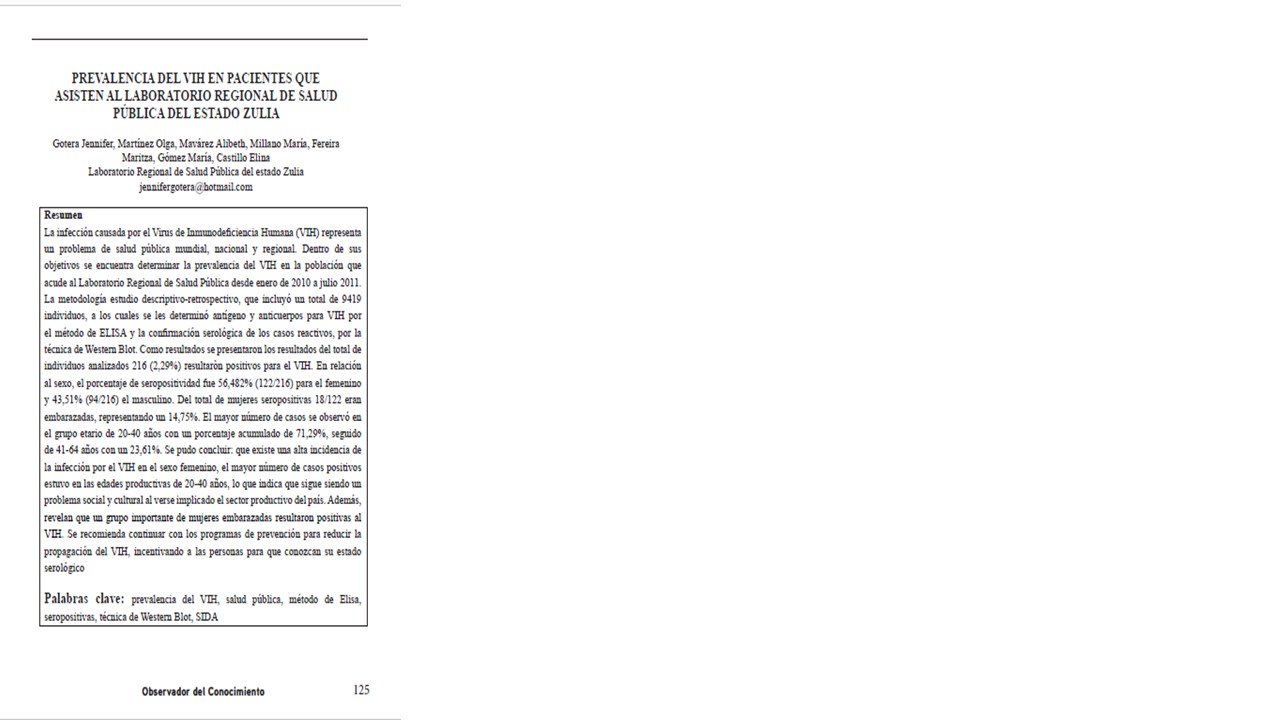Prevalence of HIV in Patients Assisting the Regional Laboratory of Public Health of the State Zulia
Keywords:
HIV prevalence, public health, Elisa method, seropositive, Western Blot technique, AIDSAbstract
The infection caused by the Human Immunodeficiency Virus (HIV) represents a global, national and regional public health problem. Among its objectives is to determine the prevalence of HIV in the population that goes to the Regional Laboratory of Public Health from January 2010 to July 2011. The descriptive-retrospective study methodology, which included a total of 9419 individuals, who were determined antigen and antibodies for HIV by the ELISA method and the serological confirmation of the reactive cases, by the Western Blot technique. As results, the results of the total of analyzed individuals 216 (2.29%) were positive for HIV. In relation to sex, the percentage of seropositivity was 56.482% (122/216) for women and 43.51% (94/216) for men. Of the total of positive women 18/122 were pregnant, representing 14.75%. The greatest number of cases was observed in the age group of 20-40 years with an accumulated percentage of 71.29%, followed by 41-64 years with 23.61%. It was concluded that there is a high incidence of HIV infection in females, the largest number of positive cases was in the productive ages of 20-40 years, which indicates that it remains a social and cultural problem to be seen involved the productive sector of the country.
Downloads
References
InfoRed SIDA (2000). VIH y SIDA, [en línea]. Nuevo México, México. http:// www.ctv.es/USERS/fpardo/vihtto.htm Kilmarx PH. Global epidemiology of HIV. (2009). Curr Opin HIV AIDS. 4: 240-246.
Ministerio del Poder Popular para la Salud. (2010). Guía Nacional para la prevención del VIH-SIDA.
ONUSIDA. (2007). Métodos para las pruebas del VIH. Actualización Técnica, [en línea]. http://www.unaids.org/es/.
ONUSIDA. (2010, 12 de febrero). Report on the global AIDS epidemic, [en línea]. Recuperado el 12 de febrero de 2011, de http://www.unaids.org/ globalreport/Global_report.htm.
ONUSIDA. (2011). Informe de ONUSIDA para el día Mundial del Sida, [en línea]. http://www.unaids.org
Salas, H. y Campos, J. (2004). Situación Epidemiológica del VIH-SIDA en Venezuela, Informe ONUSIDA, Caracas.
Teva, I.; Paz Bermúdez, M.; Ramiro, MT.; Buela-Casal, G. (2012). Situación epidemiológica actual del VIH/SIDA en Latinoamérica en la primera década del siglo XXI. Análisis de las diferencias entre países. Rev. Med. Chile. 140: 50- 58.
UNICEF, UNAIDS, WHO, UNFPA. (2008). Children and AIDS: Third Stocktaking Report, [en línea]. New York, EEUU. UNICEF. VIH. http:// es.wikipedia.org/wiki/Virus_de_la_ inmunodeficiencia_humana.
WHO, UNAIDS, UNICEF. (2009). Towards Universal Access. Scaling up priority HIV/AIDS interventions in the health sector. Progress Report. Geneva: World Health Organization.

Downloads
Published
How to Cite
Issue
Section
License

This work is licensed under a Creative Commons Attribution-NoDerivatives 4.0 International License.







